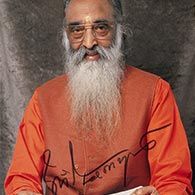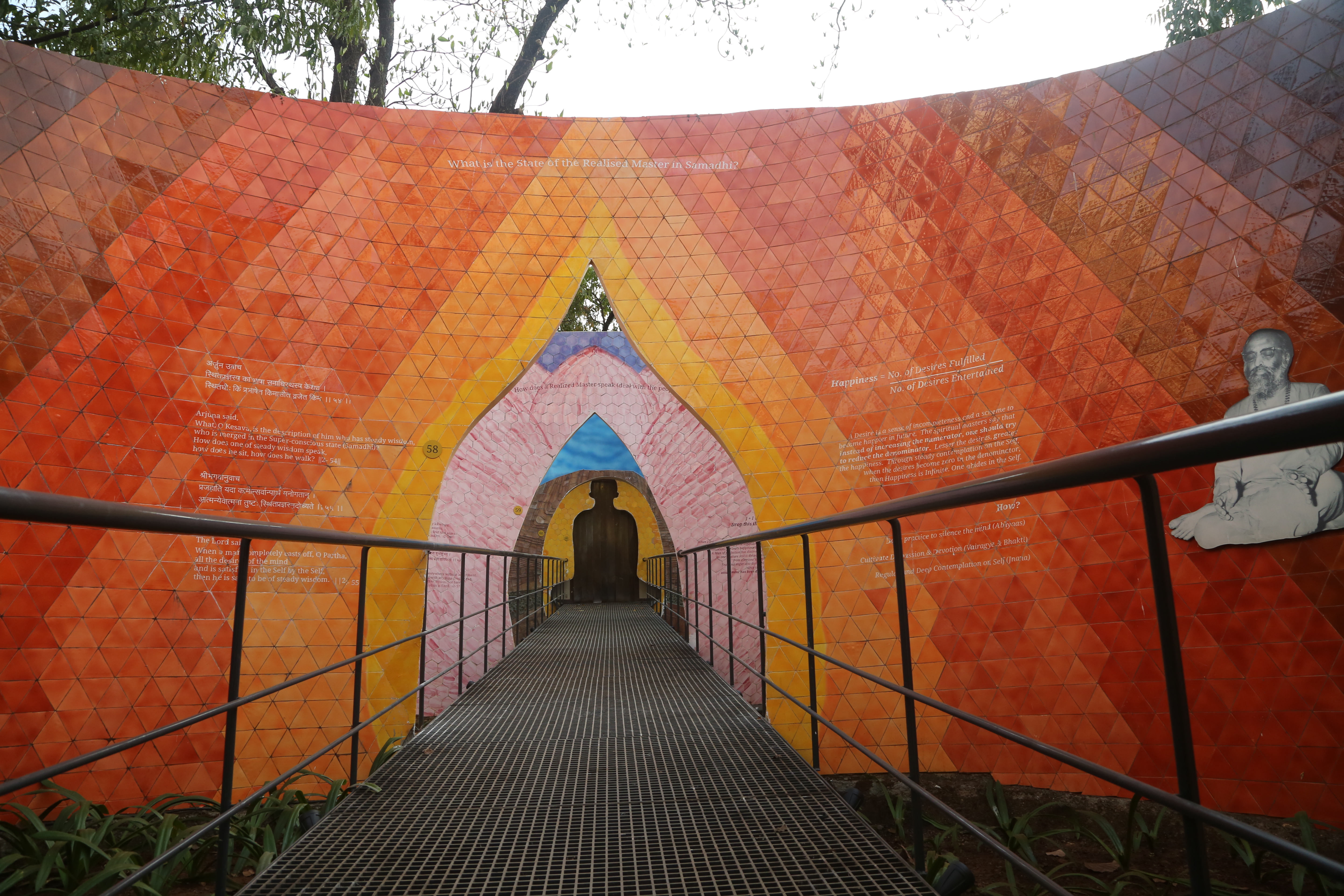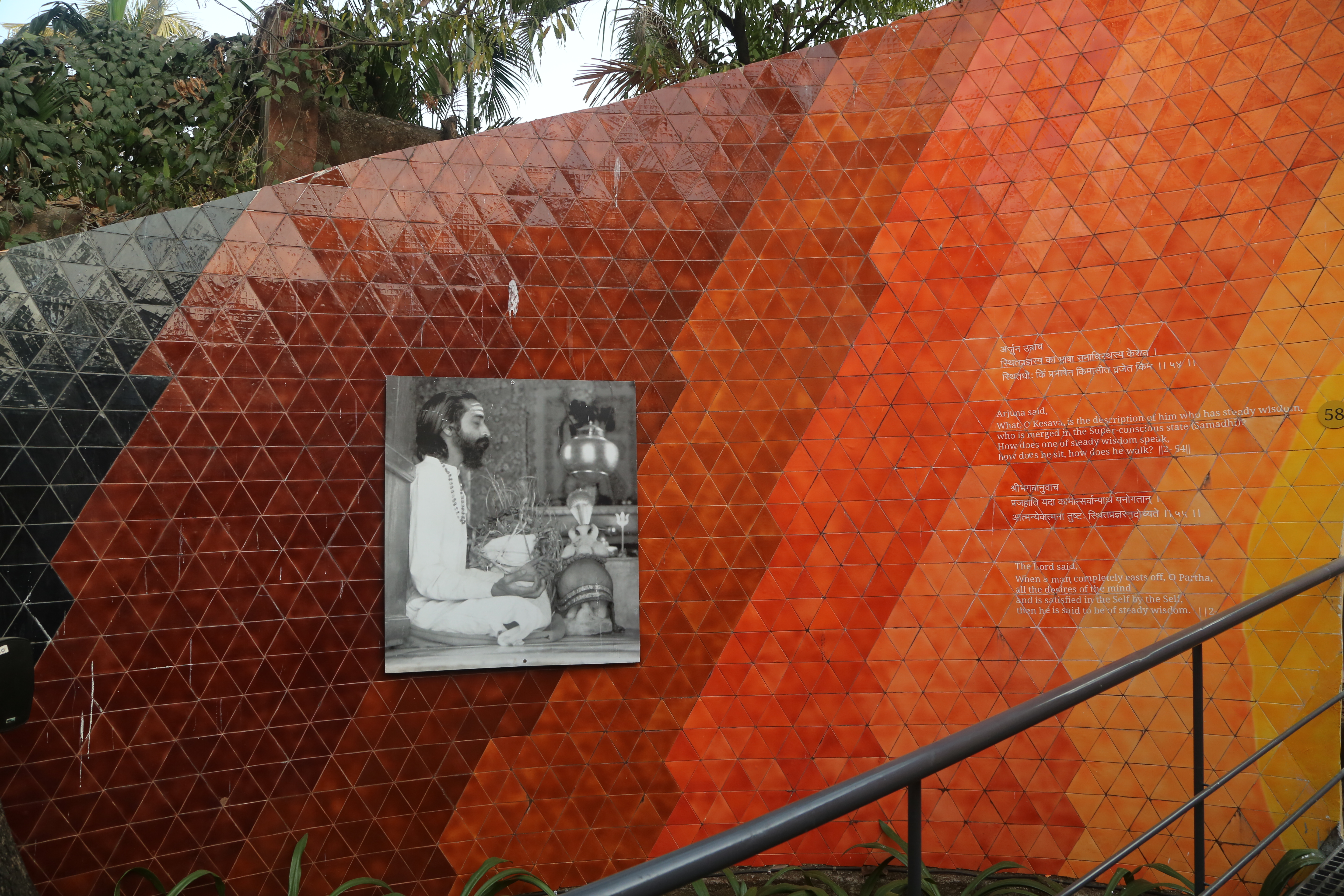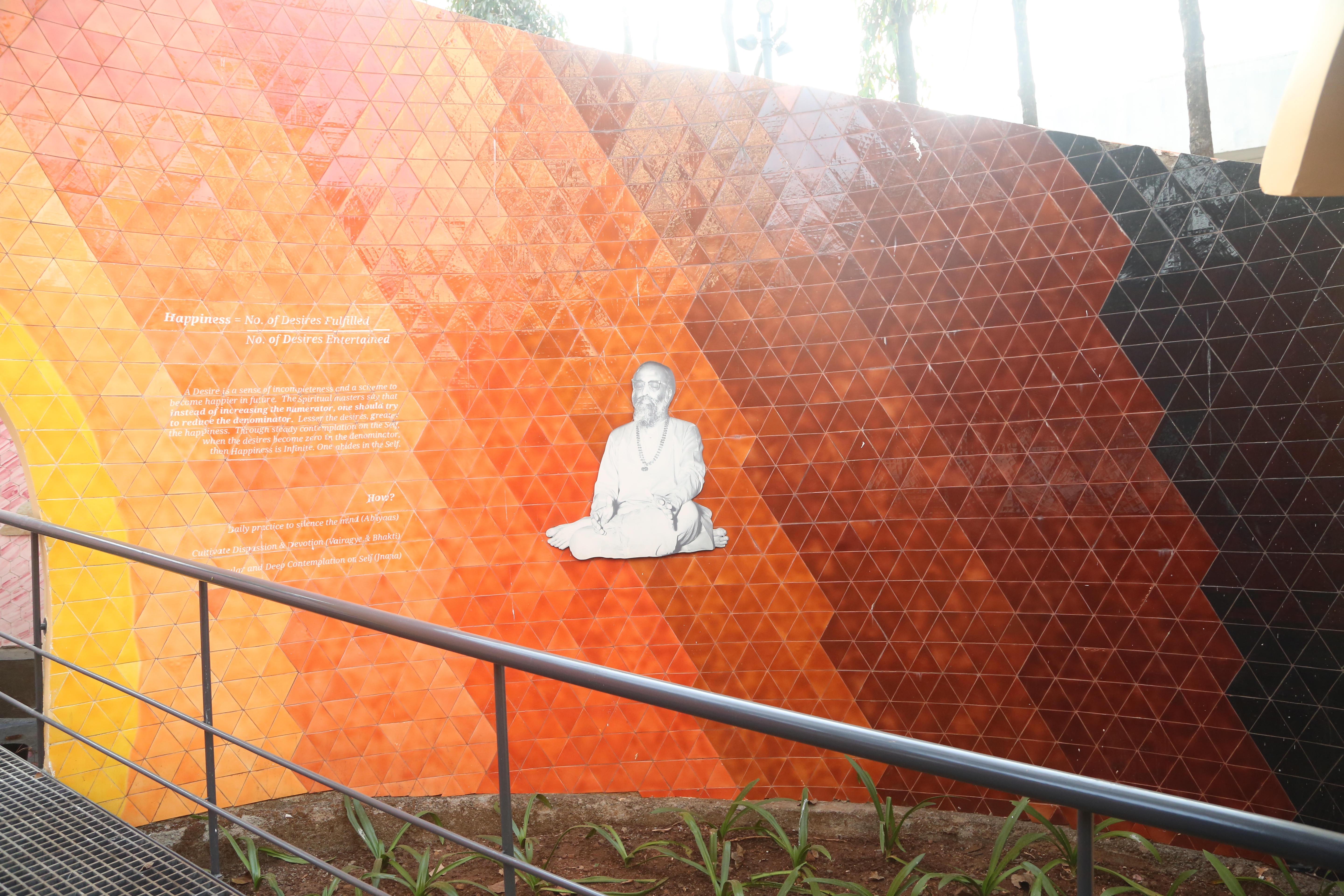Ye gunaah sarva-shaastreshu varnyante brahmajnaaninaam |
Tairayam sarvadaa purno raajate sarva yoginaam
Fully endowed with the virtues of the knowers of Brahman as described in all scriptures, he ever shines among all yogis.
A Man of Realisation
Knower of Brahman becomes Brahman like the salt doll becomes one with the ocean. Brahmavid Brahmaiva Bhavati says Mundaka Upanishad. The qualities of a Realized One are described in the 18 verses of Sthitaprajna Lakshana from Geeta Chapter 2. These 18 verses of Sthitaprajna Lakshana can be the guiding light or the means for us to reach the Goal of Our Life i.e Self-Realisation. Swami Chinmayananda loved and lived this description. He never projected himself as a Great Realised Master. He lived serving everyone as His Own Self.
Sthitaprajna Lakshana from the Geeta
18 verses of Sthitaprajna in chapter 2 from verse 55 to 72, are divided into the following sections based on Arjuna’s question in verse 54:
1. What is the State of the realised master in Samadhi?
2. How does a realized master speak? Meaning - deal with the situations?
3. In what is the realized master established?
4. How does a realized master move about in the world?
The answers are the relevant verses of the Geeta along with equations that Swami Chinmayananda used, for us to understand the concepts of Vedanta clearly and deeply.
What is the state of the realised master in samadhi?
अर्जुन उवाच
स्थितप्रज्ञस्य का भाषा समाधिस्थस्य केशव ।
स्थितधीः किं प्रभाषेत किमासीत व्रजेत किम् ॥२- ५४॥
Arjuna said: What, O Kesava, is the description of him who has steady wisdom, who is merged in the Super-conscious state? How does one of steady wisdom speak, how does he sit, how does he walk? ॥2- 54॥
__________________________
श्रीभगवानुवाच
प्रजहाति यदा कामान्सर्वान्पार्थ मनोगतान् ।
आत्मन्येवात्मना तुष्टः स्थितप्रज्ञस्तदोच्यते ॥२- ५५॥
The Lord said, When a man completely casts off, O Partha, all the desires of the mind and is satisfied in the Self by the Self, then he is said to be of steady wisdom. ॥2- 55॥
This is the state of a Realised Master in Samadhi. Happiness = No. of Desires Fulfilled No. of Desires Entertained.
A Desire is a sense of incompleteness and a scheme to become happier in future. The Spiritual masters say that instead of increasing the numerator, one should try to reduce the denominator. Lesser the desires, greater the happiness. Through steady contemplation on the Self, when the desires become zero in the denominator, then Happiness is Infinite. One abides in the Self.
A Man of Realisation
“Are you Realised?”
“I am on the verge of it. I will not realise until, you too, my listeners come with me. I am waiting for company. Alone I do not want to go.” - Swami Chinmayananda’s Radio Interview in 1974, USA
Knower of Brahman becomes Brahman like the salt doll becomes one with the ocean. Brahmavid Brahmaiva Bhavati says Mundaka Upanishad. The qualities of a Realized One are described in the 18 verses of Sthitaprajna Lakshana from Geeta Chapter 2. These 18 verses of Sthitaprajna Lakshana can be the guiding light or the means for us to reach the Goal of Our Life i.e Self-Realisation. Swami Chinmayananda loved and lived this description. He never projected himself as a Great Realised Master. He lived serving everyone as His Own Self.
Desireless
Abiding in Self
Undisturbed
Beyond attachment, fear and anger
Equanimous
Master of The Senses
Devoted to The Supreme
Without Strong likes and dislikes
Calm mind
Steady intellect
Happy
Awake to the Self
Asleep to selfishness
Ever full like the ocean
Peaceful
Are you Realized?
Q. Swamiji, I wanted to ask a question, and I am asking it with all reverence. If it is an improper question, you can explain why it is. But wanted to know if you yourself have experienced that state of pure consciousness.
Swami Chinmayananda’s answer: Now that the question is asked, the question is valid. The answer is utter silence. You may not understand the logic about it. I have to explain it a little at length. I am afraid.
Recently in India, I was travelling in a train. A youngster who had no faith in religion, a die-hard critic of religion, when he saw the swami in a train didn’t like it and lifting up his nose a little, asked me critically, “Swami, why don’t you swamis do some work in the country? When we are trying to rediscover our nation and our socialistic pattern of living, why don’t you all work like Christian Missionaries are working, the followers of Islam are working? Why don’t you Hindu mahatmas work?
When such empty discussions start, the swamis generally keep silent and to encourage that silence, we take the mala in the hand so that anybody can understand that he is doing the mala and therefore he need not answer the question.
Thus I kept quiet. He started a scathing criticism of mahatmas who are not doing political work or social work, are not coming to the field of action; but are only contemplative masters.After some time he realized that there is one swami al least who is doing a little bit of work in India – He was told by his friend in Calcutta and he remembered. He took a book from his box showing it to me, he asked “Swamiji do you know Swami Chinmayananda, who is the author of this book?”
This man had never seen me. Now what answer, my friend will I give him? He is asking me if I have met Swami Chinmayananda. I kept silent and I was smiling as pleasantly as I could, as I smiled to you when you asked me whether I have experienced the divine. Neither could I tell fellow passenger in the train that I am Swami Chinmayananda nor I could say that I have never seen him. ’Never seen him’ would have been a blank lie. And if I would say I have seen him, I would have saved me from the first question. But next immediate question of his, I will never be able to answer. Because he will certainly ask me, where did you see him and what were the circumstances in which you saw him…
It was myself and therefore I could not say I saw him nor I could say I have never seen him.
Luckily, when I gave the book back to him, he noted that on a front page was a picture. When he saw the picture he looked at it and then he looked at me and then got up from there and asked, “Are you Swamiji?” All that I could do was to shake my head to affirmative.
Similarly if you ask me if I have seen God or realized the truth, you are giving me a free hand to bluff you, because if I tell you “Yes, I have realized God,” you can’t check up. Nor can’t you test whether I am realized or not. So the best thing is never go about asking anybody, “ Have you realized the truth?” You move towards it. You move in yourself towards Reality. To the extent you have moved into the plane of consciousness. You shall recognize who has really realized this Truth around you. Just as a musician alone can understand another musician, it is only one surgeon who can understand the beauty of another. It is not by certificates that we understand. Even if I carry a certificate from my teacher stating – I hereby certify that Swami Chinmayananda is a realized one – that certificate will have no value at all. You must recognize that in the quality of my actions, in the beauty of my relations, in the spirit of my words, in the melody and the rhythm that I pour out, the fragrance that I bring in my contact with others.. How do we know that Ramakrishna Paramahansa has realized the Truth? How do we say that Vivekananda is the realized one? I is not that one generation has to pass a judgment on them. It is Time that will declare it. Such mighty men, when they come in the world and move about, may not be recognized in their own time. But the world will not willingly let their presence die. It will be felt with or without body. That presence or divinity is not declared by anyone.
In fact Vivekachoodamani of Shankaracharya declares it and Kenopanishad confirms – ‘One who says that I have realized the truth has not realized anything. This truth is unknown to those who know it.” It is in the language of contradiction. The teacher had to explain because it is a subjective, personal, private, Sir, to declare on the air.
But in fact, between you and me, I honestly confessed – I have not realized. I am on the verge of it. But I will not realize until you too, my listeners, come with me. I am waiting for company! Alone I don’t want to go!
Anecdote:
A devotee goes to Swami Chinmayananda at the end of the talk and puts a crown on him, teeka on him, jewels on him etc. and then gives him a flute. Swami Chinmayananda takes it and puts it on his lips in a krishna pose and says -This is a sight that has never been seen and will never be seen again - Krishna with a beard.
More Info
“When the mind is not allowed to dissolve into a mere state of trance, nor running into the world of objects, that is the time when you realize Brahman. The mind ends. That which remains is your own Self. The Unborn is realized by the Unborn. Consciousness becomes Conscious of itself.
Where the thoughts retire and disappear slowly; Where the mind and intellect are held at conscious attention; Through dedicated efforts at Yoga; Where the mind has ended And you are not pushed into a dark abyss of Sleep; Where the Self recognises the Self; Just as a waker recognizes a waker; Wherein he discovers total peace; No more whiff of desire Where infinite happiness is experienced, From there HE never comes down again Under any circumstance”
“When the last thought is thoughted… no more thought is thoughting..
Then ‘Shiva’ happens. Just BE. Let ‘Shiva’ Happen.” (‘Shiva’ means Existence-Consciousness-Bliss)
How to achieve this state of freedom from desires?
a. Daily practice to silence the mind (Abhyaas)
b. Cultivate Dispassion & Devotion (Vairagya & Bhakti)
c. Regular and Deep Contemplation on Self (Jnana)
Design Notes
A Man of Perfection
The visitor walks through an ascending wooden ramp that takes them through four curved structures cast in ferro-cement. Each curved niche represents one question of Arjuna about the Realised Master. In each curved surface, there are equations, pictures of Swami Chinmayananda on the right side and a form of a Yogi on the left side along with methods to practice and discover the state indicated.
The first aspect is depicted through a flame that represents the stillness and the light that a Realised Master carries. It is the analogy from the Geeta which says that the mind of a Yogi is like a flame without a flicker, in a windless spot. The visitor enters the archway which is shaped like a flame.





